
Helen Mayer takes a look at how to establish best practice for open studio events.
Open studios: best practice
Open studio events have mushroomed nationally over the last two decades. Most follow a basic pattern creating an opportunity for a number of artists to open their normally private studios and workplaces to the public for a set period of time, advertised through a printed brochure and associated website. However, there is no single model for the financial mechanisms, or management and membership structures. Some are entirely artist-run, some are run wholly or in part by a local authority or council, others are part of a bigger arts or tourism festival. Events also cover a wide variety of geographic areas, varying from entire counties to individual towns or cities.
Whatever their size or make-up, there is a common focus for open studios, and that is sustainability. In 2005, Surrey County Arts approached Arts Council England (ACE) for help with ways of sourcing funding for their open studio event, Surrey Artists Open Studios (SAOS). Whilst being unable to fund open studio events directly, ACE is keen to see the movement develop, and granted funds for SAOS to host a best practice forum for the South East region the following year. A focus group formed from the participants then made a comparison of their histories and structures, which under the editorship of Caroline Jackman, Surrey Visual Arts Officer, emerged as the booklet Key to Success Open Studios Best Practice for the South East, published in May this year. A series of key themes have emerged through this work: overall management structure, funding, the role of the artist (and volunteers), networking, marketing/audience incentives and evaluation.
Management issues
How an individual event structures its administration is probably the factor that varies the most. This will depend on the size and geographic spread of the event, its aims and objectives, and how it is funded. Whatever model is adopted, be it managed by an individual assisted by volunteers, or a steering group of individual artists who receive payment or a fee waiver to undertake specific admin roles, the keywords here are teamwork and clear lines of communication. This applies on several levels: within the steering group, between the participating artists and the steering group, and between the event and external bodies (council arts representatives, schools/colleges etc.).
Funding sources
Basic funding comes from artists fees and/or annual subscriptions, advertising space in brochures and websites, local authority grants and business sponsorship. But consideration can also be given to wider issues, which again will depend on an events structure and location. There may be opportunities for forming funding partnerships with organisations involved in engaging audiences through education; offering professional development and training opportunities; or getting involved in local initiatives such as special exhibitions or the commissioning of new work. If raising the profile of open studios can increase awareness of the economic and cultural benefits to the local economy, businesses may be more inclined to support their development. This is a step beyond the core activities of opening studios and encouraging visitors to them, but it is a question that needs to be addressed if events are to develop their profile and through that, maintain sustainable income streams.

The role of the artist
Each open studio event is also a collection of mutually dependent individuals: the team at the helm relies on the individual artists presenting a professional studio as much as the artists rely on the management to organise a professional event. For this to happen, the organisation needs to support its artists with helpful guidelines on studio presentation, publicity know-how and a code of conduct for participants and organisers, so that expectations are clear. Data from well-designed evaluation forms can provide valuable insights on audience profiles and highlight areas for development for the future.
The wider picture
The benefits of the opportunity for artists to network, share information and ideas and become involved in their local arts communities are self-evident, but networking is also productive for the events themselves. By nature, open studio events tend to have evolved in isolation, responding to the particular and sometimes peculiar needs of their location. A regional forum opens welcome opportunities for discussion, comparison and learning from each other. The initiative has been taken to a national level through the development of the Open Studio Network, an organisation being developed by a steering group, with the support of ACE. It has five principal aims:
- to facilitate the exchange of information and ideas via a web site catering to the needs of event organisations, artists and the public
- to organise and support exchanges, collaborations and joint projects between member events and other organisations in the UK and internationally
- to organise a biennial national conference of member events and an annual public promotion of all events
- to carry out an ongoing programme of advocacy and promotion on behalf of all events
- to research and develop practical support, applicable to all events, e.g. a national liability insurance scheme, the introduction of a zero interest art purchase scheme and licensing issues.
The Network is currently in its early stages, but as a much-needed umbrella organisation will provide both a source of support and information, and a means to raise the profile for what is collectively a large section of the arts community with a genuinely inclusive audience.

Helen Mayer is currently Publicity Officer for South East Open Studios and on the Steering Group of Open Studios Network.
w: http://www.seos-art.org, http://www.openstudiosnetwork.co.uk
Key to Success Open Studios Best Practice for the South East highlights three events in depth: South East Open Studios (an artist-run organisation covering Kent and East Sussex), Surrey Artists Open Studios and Artists & Makers (a local authority and artist-run organisation for Worthing & Horsham). There are also brief case studies from Cambridge, Suffolk, the Forest of Dean, Stroud Valley Arts and North East Open Studios. To obtain a copy contact Surrey Arts.
t: 01483 757258



